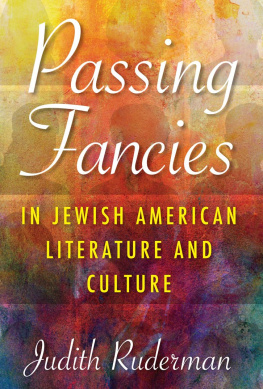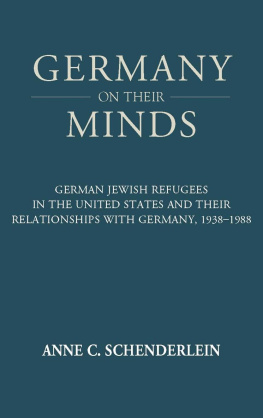C OPYRIGHT 1999 BY W AYNE S TATE U NIVERSITY P RESS,
Detroit, Michigan 48201.
All material in this work, except as identified below, is licensed under a Creative Commons Attribution-NonCommercial 3.0 United States License. To view a copy of this license, visit https://creativecommons.org/licenses/by-nc/3.0/us/.
All material not licensed under a Creative Commons license is all rights reserved. Permission must be obtained from the copyright owner to use this material.
Library of Congress Cataloging-in-Publication Data
Pickus, Keith H., 1959
Constructing modern identities : Jewish university students in Germany, 18151914 / Keith H. Pickus.
p. cm.
Includes bibliographical references (p. ) and index.
ISBN 978-0-8143-4352-4 (paperback); 978-0-8143-4351-7 (ebook)
1. Jewish college studentsGermanyHistory19th century. 2. JewsGermanyHistory18001933. 3. Jewish college studentsGermanySocieties, etc.History19th century. 4. JewsGermanyIdentity. 5. GermanyEthnic relations. I. Title.
DS135.G33 1999
378.1'982'9924043DC21
99-11845
D ESIGNER: S. R. T ENENBAUM
Grateful acknowledgment is made to the Koret Foundation for financial support in the publication of this volume.
The publication of this volume in a freely accessible digital format has been made possible by a major grant from the National Endowment for the Humanities and the Mellon Foundation through their Humanities Open Book Program.
Wayne State University Press thanks the following individuals and institutions for their generous permission to reprint material in this book: Paul Fairbrook; The Leo Baeck Institute; and Stanford University Press.
http://wsupress.wayne.edu/
Preface
Few people today would challenge the claim that the intersection of German and Jewish history conjures up powerfully evocative images. The contorted face of Adolf Hitler delivering an emotionally charged speech, the minions of black-booted soldiers goose-stepping through the streets of Berlin and the smoke-belching crematorium of Auschwitz are but a few of the historical portraits that emerge when reflecting upon the subject of German Jewry. Not only does our historical memory of Jewish life in Germany focus on forces of destruction, but the tragic reality of the Holocaust casts a long and foreboding shadow over the historical scholarship that portrays Jewish life in Germany before the advent of Nazism. Given this situation, therefore, it is not surprising that much of the literature on nineteenth-century German Jewry is concerned with the rise of antisemitism and Jewish responses to it. Seldom does the historiography of German Jewry reflect the fact that antisemitism was not the determinant influence on the lives of many German Jews.
The question, then, is how does one strip away the layers of historical memory that may distort the image of nineteenth-century German Jewry? Is it possible to sketch portraits of German Jewish existence that are not dominated by discrimination and defeat? If so, what investigative strategies can be employed to create them? These questions provide the impetus for the analysis presented in this book.
Constructing Modern Identities examines the identities of nineteenth-century Jewish university students in Germany, a small but important segment of German Jewry.
The process of emancipation and concomitant emergence of a civil society made it possible to separate ones religious and public identities. Before Germany was unified and the emancipation of the Jews was complete, most Jewish university students relegated their religious identity to the private sphere and avoided outward proclamations of their Jewishness. Although the privatization of Judaism enabled Germanys Jewish population to function as German citizens without converting to Christianity, the perpetuation of Christian influences in German society created a dialectical situation wherein the maintenance of Jewish identity was at odds with the Christian character of German society. As it became increasingly clear that Jewishness, even when expressed privately, prevented German Jews from enjoying the full benefits of citizenship, small groups of Jewish university students began to rearrange their self-images and publicly display what Jews had been reluctant to express in the past.
Members of Jewish student associations, all of which emerged after 1881, put forward public expressions of Jewishness that would have shocked previous generations. While the ideologies and foci of these organizations ranged from an integrationist agenda to Jewish nationalism and religious orthodoxy, membership in a Jewish student association provided one with an opportunity to openly proclaim ones Jewish heritage. At the same time, however, Jewish student groups were also imbued with sufficient German cultural characteristics to enable their members to function within the university environment.
Unlike their more organized brethren, students who did not join a traditional organization could not rely on a prepackaged identity to balance the demands of Deutschtum (Germanness) and Judentum (Jewishness). While some participated in nondenominational academic associations and others formed their own social coteries, most noncorporate Jewish students sublimated their Jewishness in favor of other concerns. Consequently, their public identity profiles were virtually indistinguishable from those of unincorporated Gentile students.












